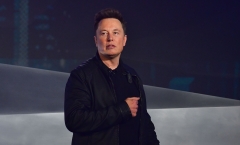
Tesla co-founder and CEO Elon Musk speaks during the unveiling of the all-electric battery-powered Tesla’s Cybertruck at Tesla Design Center. (Photo credit: FREDERIC J. BROWN/AFP via Getty Images)
America’s partnership with the commercial space industry took a step forward with the Space Force’s contracting decisions for Phase 2 of the National Security Space Launch (NSSL) on Aug. 7. At the same time, however, these awards have raised questions about budgetary changes that contractors may impose.
The United Launch Alliance (ULA) and SpaceX received launch service contracts for fiscal years 2022 to 2027. The Pentagon divided the contracts on a 60-40 percent split, with ULA receiving $337 million for two missions and SpaceX accepting $316 million for one. While Phase 2 of the NSSL seems to offer reasonable savings from the $450 million that NASA spent on individual shuttle launches, the amount that SpaceX received for a single mission has raised eyebrows.
Initially, Elon Musk claimed that the Falcon Heavy rocket – one of the two models offered to NSSL, and the most expensive of the two, would have a maxed-out cost of $150 million per launch. The $316 million price tag it received for one NSSL mission is over double that estimate, and almost the same price that ULA received for two rockets.
While the $316 million SpaceX receives also includes funding for support costs, those costs still should not explain the significant difference between Musk’s claim and the funding allotment that SpaceX ultimately received. In fact, just four months ago, SpaceX earned a Falcon Heavy contract with NASA for nearly $200 million less, inclusive of all costs.
Rising costs are becoming a trend at SpaceX. For example, the cost underestimating is the primary reason that a 2018 NASA audit found the agency would spend roughly $400 million more than anticipated on its 2020-2024 delivery contracts. Initially, NASA found that SpaceX’s prices were already notably higher than the other two contractors it selected. Then, after receiving the award, SpaceX had to raise prices once it gained “a better understanding of the costs involved after several years of experience with cargo resupply missions.”
The biggest threat to our national security is our debt – not China or Russia. The Defense Department needs to account for every dollar in the budget, which Congress is considering shrinking even further through the NDAA. Every dollar expended on launch procurements is a dollar that could go to other matters critical to our national defense.
Budgets need to have black and white costs. SpaceX must be precise when working with the U.S. military. If this proves impossible, the government should consider working with other contractors.
Northrop Grumman and Jeff Bezos’ Blue Origin recently had their Phase 1 Launch Services Agreements terminated. These two companies need to continue working to improve their products to create a more competitive environment in the U.S. space race. These added market forces will yield better results for the taxpayer and our space explorers.
Innovation and the free market made the Space Force’s NSSL possible in the first place, and it is innovation and the free market that will make the program even more efficient in the future. The time for heightened competition is now.
Phil Kiver, Ph.D., is an Army veteran of Iraq and Afghanistan. He received his doctorate in strategic studies at Henley-Putnam University.

